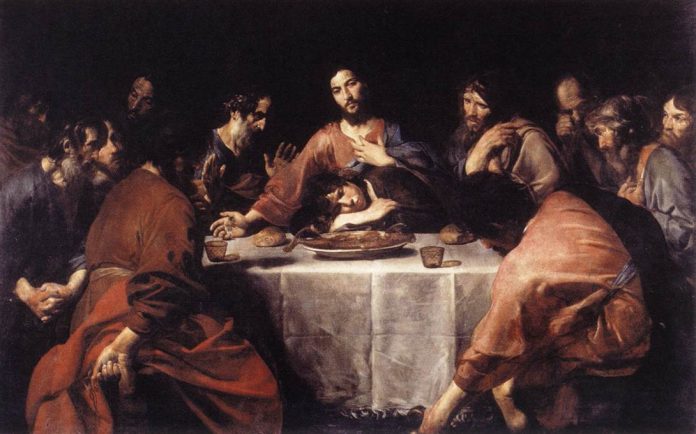Often, the simplest facts are the most important—and the most frequently unadverted to. Take the Last Supper, for instance. Obviously, the Apostles had to be present in order to participate in it. Wonderful as it was, it would have been of no benefit to Peter if he had decided not to attend. And yet, this seemingly trivial observation takes us into the heart of our faith, viz., that in Jesus, God, who is everywhere, was located at a given place, at a given time. That’s what we mean when we say that Jesus Christ was God incarnate, in the flesh, here and now. The implications of this fact are important. For one thing, it means that two thousand years ago in Palestine to encounter God in Christ you had to go where he could be found, for he was here and not there, present today and not yesterday or tomorrow. People recognized and acted on this fact. Recall the paralytic lowered through the roof when the house was too full to permit access through the door; or the crowds that followed Jesus into the desert; or Zacchaeus in his sycamore three; or the woman who came to anoint Jesus in the house of Simon the Pharisee.
A second implication of the physical presence of God in the man Jesus is this: that Jesus rose from the dead in that self-same body. In other words, in the risen Christ, God is still located physically. The holy women encountered him at the tomb, and the two disciples on the road to Emmaus. Thomas touched his wounds in the upper room, and Jesus fed the Apostles on the shore of the Lake of Galilee.
And here’s a third implication; his having kept his body means that still today the Godhead is located in the man Jesus. If we wish to have contact with Jesus we must go where he is to be found, we must see him and hear him and touch his body. But where is it to be found? How can he be present in the flesh to the millions of believers around the world? He himself has told us how: “Take and eat; this is my body. “Take and drink; this is my blood.” He is present here on the altar under the species of bread and wine. That’s why I come to Mass: he’s here and I want to be where he is. And thus, the doctrine of what is known as “the real presence” is the inevitable consequence of the Incarnation itself. Christ is also in the words of Scripture as they are proclaimed at Mass; we hear him speak. And in the assembly, for as Saint Paul tells us, the Church is the body of Christ.[1] He is thus present as concretely and as really as he was during his earthly life, and it would be as foolish for me to stay away as it would have been to remain in my room when news came that Jesus was in town that day, preaching and working wonders. I’ve on occasion heard people say, “I go directly to God,” a statement that makes me shudder in that it implicitly denies the role of Jesus, “the sole mediator between God and man.”[2]
A final implication of the Incarnation is that entire sacramental system, which as Catholics, we identify as the essence of our religion. As Christ acted, so does the Church. He spoke, touched, anointed and blessed; and so does the Church. God gave us a pattern in the life of Jesus, which we have the consolation of following in the seven sacraments, of course, but also in what I may term a sacramental mentality or, better, a sacramental spirituality.
[1] Eph 1.22-23.
[2] 1 Tim 2.5.


